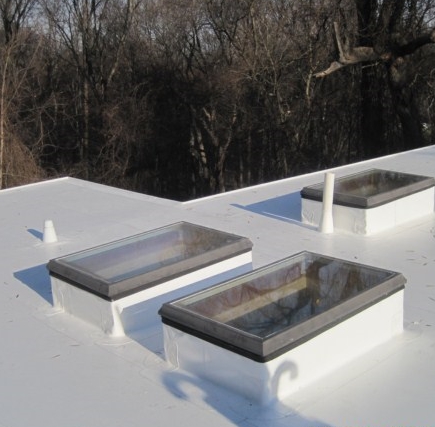Flat Roof Series 4: The Modern Systems You Should Know
The future is bright for commercial flat roofing systems. That’s the good news. The bad news is that many commercial (and even residential) flat roofing contractors are still installing outdated technologies, as we discussed last week. At Van Martin, we are doing our part to raise awareness about the superior options available, and we’re gaining traction.
EDPM Rubber Flat Roof
Ethylene propylene diene monomer (EDPM) Rubber is a commonly used product for flat roofs. Its popularity can be traced to its lower price tag and the fact that no special equipment is required to install your rubber roof. Despite its popularity, rubber roofs are prone to leaking. The roof’s seams are glued together, and the adhesive often breaks down within five to seven years.
Moreover, much like other roofing materials, too many contractors advertise that they install rubber roofing materials without having sufficient knowledge and training. As a consequence, we frequently make rubber roof repair service calls to repair the issues caused by poor workmanship. The worst situation is when we make service calls for a relatively new roof. We hate to see that happen to a building owner.
TPO Roofing
A single-ply roofing membrane much, Thermoplastic polyolefin (TPO) may appear similar to PVC roofs, but they are far inferior. The biggest problem with the TPO option is that everything hinges on finding a quality flat roofing contractor. TPO roofs have are commonly problematic mainly because manufacturers skip on using critical ingredients in the formulation of the TPO membrane. We specialize in TPO roof repair and can extend the life of your roof with a unique warranty you can get with us even if we didn’t install it. We will elaborate on our maintenance plan later on in the series.
Modern (Single-Ply Membranes)

IB, or PVC, roofing membrane is hands down the best flat and low-slope roofing product on the market today, and that is exactly why we choose to install PVC roofs. From Alaska’s frigid tundra to Florida’s humid summers, PVC roofs have protected buildings and everything inside it with no material failures reported since its inception in 1978. That’s 30+ years of a spotless reputation. Such leak-free performance is unheard of for flat roofs, and this material accomplishes such a feat in a variety of climates.
PVC roofs feature the exact same chemical formula found in its original design. They provide absolute water-tightness over your flat roof because their seams are hot-air welded seams.
Until the invention of single ply membranes, no effective and economical way to eliminate the leaks caused by ponding water existed. That problem had to be taken care of in the initial design/construction stage. Creating a slight pitch and multiple drains was required, and even then, ponding water caused over 75% of all flat roof leaks.
Now that we have discussed the advantages, disadvantages, and types of flat roofing systems, we will discuss in our next chapter what to look for when choosing a flat roofing contractor in the Dayton area.


